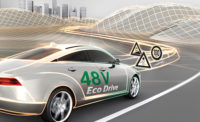Engineers Rethink 48-volt Power Systems

During the next decade, more automakers will be adopting 48-volt electrical systems to keep up with evolving driver-assist options, onboard entertainment features and other power-sapping applications. Growing demand for mild-hybrid electric vehicles (MHEVs) is also behind the trend.
Luxury German brands such as Audi, BMW and Mercedes are already at the forefront of adopting the technology. But, companies such as Ford and Toyota will soon be offering 48-volt systems on more lower-end vehicles.
“Introducing a 48-volt architecture into a vehicle requires the installation of a suitable 48-volt battery alongside the conventional 12-volt supply,” says Steve Borman, principal power electronics engineer at MAHLE Powertrain Ltd. “So, the added cost, weight, package space and complexity has generally restricted this technology to larger, premium class vehicles.
“Until recently, 48-volt battery packs have also lacked the power density, thermal stability and charging rates necessary to achieve the required system performance,” explains Borman. “However, 48-volt systems have gradually become more popular in recent years due to the development of electrical engine ancillaries such as coolant pumps, oil pumps and power steering pumps.”
The switch from crank pulley and belt drive to electric motor drive for these components provides significant fuel economy benefits, due to parasitic loss reduction. A 48-volt motor-driven pump performs better than 12-volt alternatives. Advances in electronics and software have also enabled much more accurate control of the pressure, flow rate and response time of these devices.
In addition, other 48-volt motor-driven devices, such as electric superchargers, have been developed. They offer great potential for boosting torque outputs at low engine speed without the lag issues of conventional turbochargers.
“Great advances have been made in recent years in the speed, power and performance of the 48-volt motors themselves, with the size and weight of these devices gradually reducing and the power density increasing,” says Borman. “Belt starter generators have also been developed to provide improved stop-start performance and to maintain power levels within the system. And, 48-volt systems theoretically allow brake energy recuperation at up to four times the level of 12-volt systems, due to the higher power capacity.
“The ongoing push for improved fuel economy and lower emissions has made the introduction of these 48-volt technologies progressively more attractive for mainstream vehicle applications, with the majority of OEMs now developing MHEVs as core products, predominantly based on high-efficiency gasoline engines,” Borman points out. “The resulting higher production volumes across all 48-volt systems and devices has also led to significantly reduced costs.”
According to Borman, 48-volt systems are intrinsically safe and don’t require the significant safety requirements of higher voltage plug-in systems. He says 48-volt systems use similar wiring to 12-volt systems, with no need for special materials. And, because they can transmit much more electrical power at the same current as a 12-volt system, automotive engineers can reduce cable thicknesses to save cost and weight.
“[Traditionally], the additional cost, complexity and packaging challenges of installing a 48-volt battery and associated systems into a vehicle have presented OEMs with technical and financial barriers that have proved difficult to overcome,” claims Borman. “Battery technology has only recently developed to the stage where these systems can deliver real performance and efficiency benefits while also achieving acceptable durability levels.”
Engineers at MAHLE recently developed at 48-volt battery pack that addresses those issues. It allows very high charging and discharging rates (up to 20-kilowatt peak) from a compact, low-capacity unit.
“The use of high-power lithium titanate cells allows high charge rates and ensures good thermal stability across a wide operating temperature range,” says Borman. "The pack includes a high efficiency, integrated cooling system to ensure that the cell temperature is maintained within the optimum range.
"Measurements conducted according to the new worldwide harmonized light vehicle test procedure indicate that the battery's sophisticated management system was able to keep the energy flow within high-efficiency areas," claims Borman. "This results in potential fuel economy benefits of up to 15 percent in a compact MHEV application."
Looking for a reprint of this article?
From high-res PDFs to custom plaques, order your copy today!






